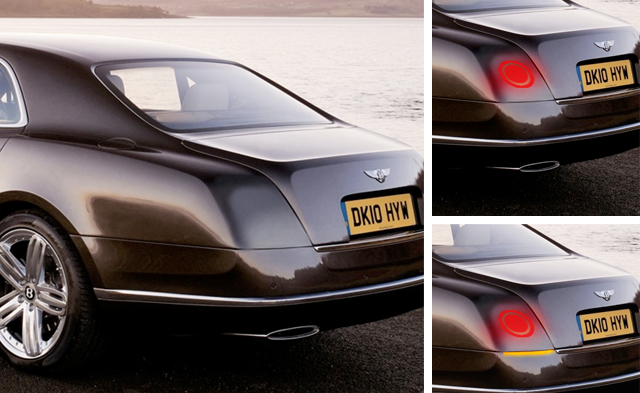Imagine this: You’re driving along the motorway minding your own business when it suddenly dawns on you that the car in front has no brake lights or indicators. The sleek lines of its rear quarter panels flow uninterrupted from back window to bumper. No lenses, no bulbs, no LEDs, no surrounding chrome trim… nothing.
As you approach the next exit, the car indicates its intention to leave the motorway; a ‘light’ magically appears on the left nearside corner, flashing orange. Off to the side of the rear left wing an auxiliary orange side indicator also flashes where there previously had been no light. As the car slows, red brake ‘lights’ appear either side, with another at high-level just above the rear window.
The car exits and the lights disappear. You follow, looking for a sign of where the indicators and brake lights were, but you see nothing. The vehicle’s paintwork once again appears smooth and unbroken. You wonder whether you’re going bonkers.
But, remember what we said at the start? ‘Imagine this’?
At this stage, fully-integrated lighting as in this scenario, is – as far as we know – hardly even on the drawing board, but automobile manufacturers go to great lengths, especially with sleek, sporty models, to design their cars with minimal wind resistance and smooth flowing lines that curve gracefully with minimal interruption. Door handles and external mirrors are integrated as much as possible; clean lines and a lower drag coefficiency are everything. Bentley for example aims for its Mulsanne model to be seamless, with nary a weld or join to be seen, and it must be annoying to automotive designers that their curvy creations have to be compromised by legally-required screw-on lenses and lamps.

Artist's impression - property of carkeys.co.uk
So auto designers will be excited to know that soon they might be able to ditch the requirement to tack on rear indicators and brake lights, and instead craft their vehicles with smooth, uninterrupted surfaces. All they need is a viable alternative to traditional automotive lighting, something that is part of the paintwork rather than interrupting it.
Enter electro-luminescent paint, which has the potential to dramatically impact on automotive lighting, and automotive design at the same time.
In a nutshell, electro-luminescent paint carries an electrical current which, when targeted strategically, can make parts (or all!) of a vehicle’s paintwork light up, in various configurations or colours. Lexus recently demonstrated this using a car whose electro-luminescent paint displayed a sort of bar graph on the sides of the car which pulsed according to the driver’s heart rate.
And, in the United States, Ohio-based company Darkside Scientific is wowing custom motorcycle enthusiasts with petrol tanks, fenders and other body parts that light up using electro-luminescent coatings. The company’s light-emitting product can be spray-painted on flat, curved, or uneven surfaces turning them into a light, although there’s no sign yet that the product will be bright enough to replace headlamps.
It was 101 years ago that Canadian Florence Lawrence first proposed the idea of an automotive ‘auto signalling arm’ attached to a rear fender, and eighty years ago that a company in the United States invented a flashing turn indicator, which first became standard on Buicks three years later. Since then we’ve seen all manner of different methods to signal indicating and braking, including the quaint ‘trafficators’ on Morris Minors etc. of the 1950s.
The increasing and widespread use of LEDs is perhaps the biggest change to vehicle lighting in recent years, but now that the principle of electro-luminescent paint has been established and is being tentatively applied, the possibilities seem limited only by imagination. Advertising, messages, Police ‘Stop’ instructions, even ‘Sorry!’ signs could all appear from nowhere on a vehicle’s bodywork.
Although for the moment it’s just custom bikers and Lexus who seem to be the few early adopters of electro-luminescence (and even the Lexus ‘heartbeat’ – which let’s face it is hardly going to help signal a vehicle’s intentions – looked more of a stunt than anything else), the use of electro-luminescent paint to take automobile light technology into the next phase seems clearly indicated.



